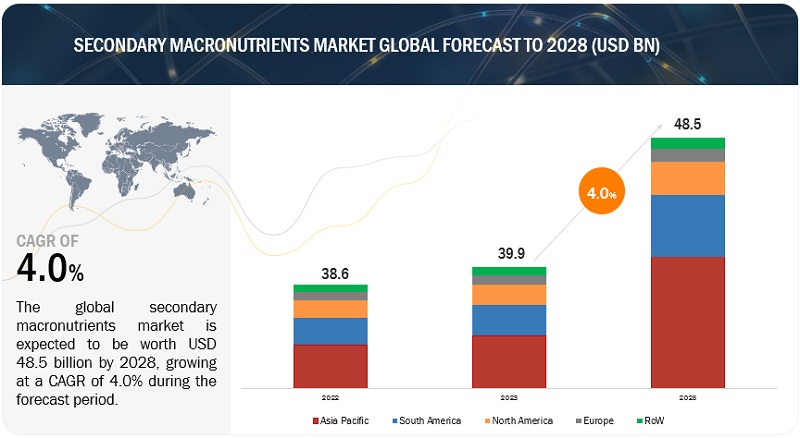
The secondary macronutrients market is expected to be valued USD 38.6 billion in 2022 and USD 48.5 billion by 2028, with a CAGR of 4.0% from 2023 to 2028. Due to the rise in the demand for food such as cereals & grains and fruits & vegetables the global secondary macronutrient market is projected to grow at a robust growth rate. Farmers are becoming more aware of the value of secondary macronutrients in crop production and are turning to these fertilizers to boost yields and quality, is further fueling the growth of the market.
Download PDF brochure: https://www.marketsandmarkets.com/pdfdownloadNew.asp?id=45874881
Drivers of Secondary Macronutrients Market
Need for increasing crop production
The consumption of animal products increases as more people enter the middle class, which in turn drives up the demand for grains and other crops to feed the animals. The amount of arable land accessible for farming declines as more people move into urban areas, necessitating an increase in agricultural production on already-existing farmland. In order to supply the needs of the urban population, it is necessary to boost the productivity of already used agricultural land and to investigate novel approaches to food production, such as vertical farming and urban agriculture. The most effective use of secondary nutrients can significantly boost the productivity of currently used agricultural land and support sustainable and creative methods of food production.
Opportunities of Secondary Macronutrients Market
Precision agriculture for nutrient control on site-by-site basis
Precision agriculture includes site-specific nutrient management, which may be applied to any field or crop. It is a technology-based technique of growing crops effectively and on-site using specialized application equipment that can maintain water and nutrients in the root zone. Precision farming has the ability to enhance output and fertilizer usage efficiency by preventing nutrients from leaching from or accumulating in excessive amounts in specific areas of the field. Precision farming is gaining popularity in industrialized nations because of the efficient use of the fertigation method, which has the potential to be a successful instrument in the judicious delivery of secondary nutrients, resulting in decreased application costs. The kind of secondary nutrient and its formulation may be entered into the information system, which can then offer an accurate analysis of the crop’s nutrient requirements, application rate, and mixing ratio inside the fertigation system.
Inquiry before buying: https://www.marketsandmarkets.com/Enquiry_Before_BuyingNew.asp?id=45874881
South America is estimated to be the fastest growing region during the study period
South America is the fastest growing region in the secondary macronutrients market. South America has a large agricultural sector, which is a significant contributor to the region’s economy. The use of secondary macronutrient fertilizers can help farmers improve crop yields and profitability. The availability of secondary macronutrient fertilizers is increasing in the South America region, making it easier and more cost-effective for farmers to use these fertilizers. Many South American countries export agricultural products to other countries, and the use of secondary macronutrient fertilizers can help ensure that these products meet the quality standards required by export markets. and hence it is projected to foster at a higher rate in the secondary macronutrients market.
Eminent players operating in the secondary macronutrients market are Nutrien Ltd. (Canada), Yara (Norway), The Mosaic Company (US), Israel Chemicals Ltd. (Israel), K+S Aktiengesellschaft (Germany), IFFCO (India), Deepak Fertilisers and Petrochemicals Corporation Ltd. (India), Coromandel International Ltd (India), Koch Industries, INC. (US) and Nufarm (Australia) among others.
